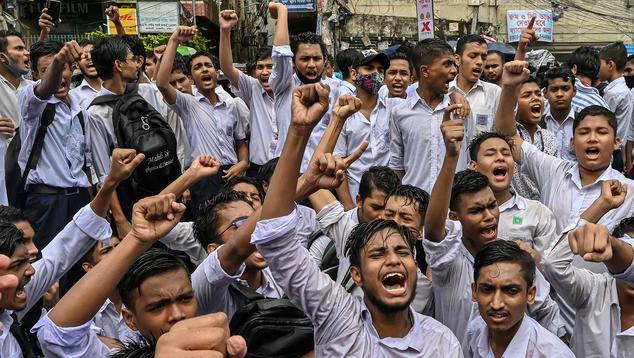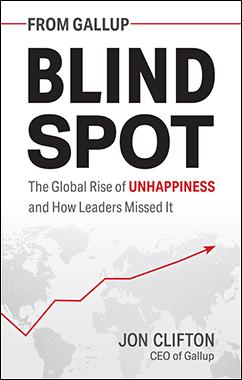The following is adapted from Gallup's new book, Blind Spot: The Global Rise of Unhappiness and How Leaders Missed It.
All leaders use indicators to measure progress. For example, if you asked CEOs what indicators they follow most closely, they would probably say revenue growth or share price. With world leaders, it's harder to know. Would they say GDP? Unemployment? The poverty rate? Maybe the Saudi king would say oil prices.
I am not entirely sure what their answer would be, but I know what they would not say. None of them would say happiness.
As a result, none of them know just how much unhappiness there is in the world today. And that is concerning because unhappiness is now at a record high. According to Gallup, people feel more anger, sadness, pain, worry and stress than ever before.
Now, I know what you're thinking: "I didn't need data to know that. The pandemic made everyone miserable. Why is that surprising?"
COVID-19 was bad for everyone, but we cannot blame the rise of unhappiness on the pandemic alone. Global misery was rising well before the pandemic. In fact, unhappiness has been steadily climbing for a decade -- and its rise has been in the blind spot of almost every world leader.
Experts know how to count almost everything: CO2 emissions, the size of urban slum populations, the contribution tourism makes to every country's economy, and even the number of trees in the Sahara desert. But while experts seem to count almost everything, they don't systematically measure how people feel.
Unhappiness has been rising worldwide for a decade, but almost every world leader missed it. Why? Because they were focused on measures like GDP and unemployment. Almost none of them were paying attention to how people were feeling.
Dear 7.7 Billion World Citizens, How Are Your Lives Going?
In 2006, Gallup began conducting global research on subjective wellbeing, which is used interchangeably with "happiness." The goal of the research was to definitively report -- by country -- how people's lives were going from their perspective. Was the world getting more stressed? Were people more hopeful? Were they getting angrier?
Thousands of interviewers have now sat with people in their homes or called them and asked them about their lives. This work now represents more than 98% of the world's population and, as of this writing, includes over 5 million interviews.
It is remarkable how open people are about sharing their sadness, their pain or their anger. But it's also concerning that so many more people are sharing these negative emotions with us.
But why? Why are so many more people feeling this way?
The answer has to do with an inequality the world is not familiar with. Leaders understand income inequality -- the growing divide between the financial haves and have-nots. What they are not familiar with is the growing divide between the haves and have-nots of a great life. This is called wellbeing inequality.
At the beginning of every wellbeing survey, we ask people to tell us how good of a life they have. Here is the question verbatim:
Please imagine a ladder with steps numbered from zero at the bottom to 10 at the top. The top of the ladder represents the best possible life for you and the bottom of the ladder represents the worst possible life for you. On which step of the ladder would you say you personally feel you stand at this time?
When we first asked the world this question in 2006, 3.4% of people told Gallup their lives were a 10 -- the best possible life. And only 1.6% said their lives were a zero -- the worst possible life.
After 15 years of tracking, those numbers have shifted significantly. The number of people living their best lives has more than doubled (to 7.4%), while the number of people living their worst lives has more than quadrupled (to 7.6%).
But it gets worse.
If you isolate the 20% of people globally who rate their lives the best and compare them with the 20% of people who rate their lives the worst, you find just how unequal the world is becoming in terms of wellbeing and happiness.
In 2006, the 20% of the world who rated their lives the best had an average life rating of 8.3. The 20% who rated their lives the worst had an average life rating of 2.5.
Now look at 2021. The 20% who rated their lives the best had an average life rating of 8.9, and the 20% who rated their lives the worst had an average life rating of 1.2. The gap in those life ratings is now 7.7 points -- the highest in the history of Gallup's tracking. The top 20% of the world could hardly be doing better, and the bottom 20% could hardly be doing worse.
You might think that income inequality explains wellbeing inequality and, therefore, rising unhappiness. That is certainly part of it. But a great life is more than just money. After studying the 20% of people who report having a great life, Gallup finds they have five things in common: They are fulfilled by their work, have little financial stress, live in great communities, have good physical health, and have loved ones they can turn to for help.
The 20% of people who rate their lives the worst have very little of any of those things. They don't have a quality job, their income is not enough to get by, they live in broken communities, they are hungry or malnourished, and they don't have anyone in their life they can count on for help. And the 20% who rate their lives this low are getting sadder, more stressed and angrier than ever before.
The point of Gallup's new book, Blind Spot, is to show where the world is suffering and where it can improve. We cannot make the world better if we do not know how it is doing. The book outlines the indicators that leaders can watch so that they are never surprised again by rising stress, sadness or anger.





